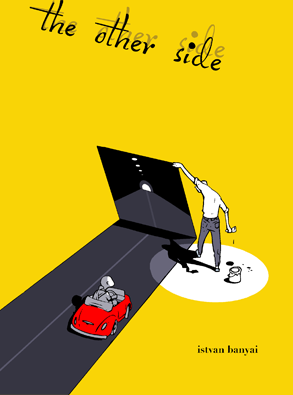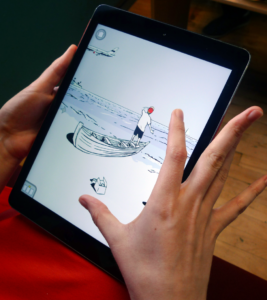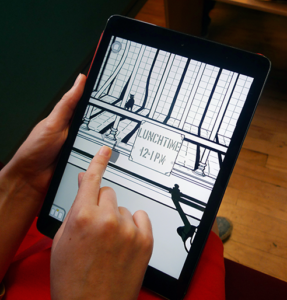Foof! It’s been a while since I’ve done one of these so forgive me while I stretch the old app-reviewing little gray cells for a second.
There was a time, best beloved, when I thought this little blog would do it all. V-blogging. Podcasting. And, yes, app reviewing. But reviewing apps is an arduous process that takes an entirely different set of muscles than those used for book reviewing. Still, once in a while you encounter an app that speaks to you. Particularly if it is a very rare literary app for kids.
In the early days of apps, publishers were under the distinct impression that since they were new and cool, they’d provide a possible revenue stream. And so, for a little while, we saw a real plethora of lovely apps based on picture books. Freight Train by Donald Crews. How Rocket Learned to Read by Tad Hills. Wild About Books by Judy Sierra. That sort of thing. It didn’t take long before simple economics made it clear that apps don’t make much in the way of moolah. You invest a lot of money at the front end, but charge only scant amounts to the customers (I mean, seriously, who’s gonna buy a $10 app?). Over a very long period of time an app might make back its money, but that’s always assuming you aren’t producing a bunch of them at once.
The end result of all this was that the picture book apps we’ve been seeing over more recent years have been of an artistic bent. Rules of Summer by Shaun Tan (with music by Sxip Shirey!) or maybe The Numberlys by Bill Joyce (which is kind of a cheat to include since the app preceded the book, but you know what I mean).
Into this uncertain landscape steps Mental Canvas. Julie Dorsey, a Professor of Computer Science at Yale University, is the Founder and CEO of this relatively new software company. Funded by the National Science Foundation’s SBIR (Small Business Innovation Research Program), the company uses Dorsey’s visual computing specialty to develop “a new digital graphical media type that sits between a 2D drawing and a 3D model.”
 Come again? Well, honestly, the only real way to explain it is to see it. And the book that Mental Canvas decided to use to kick off a lot of what it’s doing was, of all things, Istvan Banyai’s The Other Side.
Come again? Well, honestly, the only real way to explain it is to see it. And the book that Mental Canvas decided to use to kick off a lot of what it’s doing was, of all things, Istvan Banyai’s The Other Side.
Children’s librarians who’ve been in the business since 2005, do you remember this book? It was one of the first I ever reviewed at old Amazon.com. One January 23, 2006 I wrote it up (marking it as one of the last pre-blog reviews I would write) and said that, “I’m not gonna tell you that every person and child you hand this to is gonna adore it. But for pure visual adrenaline, few things will entrance and entice you better than Banyai’s remarkable effort. A book that won’t make it easy for you. Your intelligence will just have to rise to its level.”
Forgotten in the wake of Banyai’s more popular Zoom and Re-Zoom, the book finds a new life in the form of an app for kids. And as it happens, I never would have considered it but The Other Side is rather ideal in an electronic format.
If you’re unfamiliar with the story, here’s the description I wrote of the book back in the day:
“You need to understand how to read this book before you pick it up. Fortunately, the instructions are in the title itself. Everything on one page corresponds to what happens on the next by showing the “other side”. Example: One page shows a boy in a coral colored cap peeking from an airplane window. Now turn the page and you find yourself on the other side of that window. You are now in the plane looking at the back of the boy’s head from down a row of passengers. A boy floating merrily in a swimming pool seems to be quite close to the fin of a shark. Turn the page and that shark is actually the point of his own black flipper and an underwater seascape is now the focus of your attention. The pictures are sometimes like conjurings from the mind of David Lynch. In one picture a single woman wearing a thin strapped shirt (of which Banyai has always been a big big fan) sits alone in an empty auditorium, a single spotlight on a face that peeks from the curtain. Sometimes the pictures are remarkable in their simplicity too. A yellow page with a white circle show a tiny point piercing through. Turn the page and there stands a baby chick with its beak poking into the white. Taken separately each picture is a story and a world in and of itself.”
If I can work at least one David Lynch reference into a picture book review, my job here is done.
 So how does the app work? Simple. The pages, for the most part, remain intact. Unlike some apps where pages are animated or include games in their crevices, there are only two things that Mental Canvas has done to distinguish these pages. First, they’ve rendered Banyai’s two-dimensional drawings in 3D. Turn your iPad around and you can almost see above and behind the subjects. Second, they’ve done a bloody good job at incorporating sound into the design. From car engines to street noises, the inside white noise of an airplane to the sound snow makes when you compact it with your feet, the audio design is king here. The underwater scenes alone will give swimmers a kind of sense memory little heard in app technology.
So how does the app work? Simple. The pages, for the most part, remain intact. Unlike some apps where pages are animated or include games in their crevices, there are only two things that Mental Canvas has done to distinguish these pages. First, they’ve rendered Banyai’s two-dimensional drawings in 3D. Turn your iPad around and you can almost see above and behind the subjects. Second, they’ve done a bloody good job at incorporating sound into the design. From car engines to street noises, the inside white noise of an airplane to the sound snow makes when you compact it with your feet, the audio design is king here. The underwater scenes alone will give swimmers a kind of sense memory little heard in app technology.
Some apps can be handed to a child while the adult walks away to, oh I dunno, cook dinner (not that I’d have any experience with that or anything). Other apps demand parent/child interactions. The Other Side falls squarely in the latter camp. Like its book before it, a lot of questions need to be asked as you read through. Where is the book going to take you next? Did you catch the connecting picture from the previous scene? Do you think this is what’s really on the other side of that cage?
 There’s isn’t much to it beyond the book, which is a novelty in some ways. When apps are expected to shove in as many bells and whistles as conceivable, the idea of simply presenting a book with a limited concept is . . . well, it’s rather original.
There’s isn’t much to it beyond the book, which is a novelty in some ways. When apps are expected to shove in as many bells and whistles as conceivable, the idea of simply presenting a book with a limited concept is . . . well, it’s rather original.
Of the original book I pondered why it wasn’t better known, writing, “The only thing I can figure at this point is that Banyai’s style, for all the critical praise and gushing adoration it receives, doesn’t connect to children particularly well. There’s certainly plenty to confuse them here. ‘The Other Side’ hasn’t any plot, but sometimes it seems as if characters carry over from scene to scene. There are also too many danged boys wearing caps. I’m not sure if you’re supposed to infer that they are all the same boy (even though some caps are the aforementioned coral and some are a bright eye-catching red).” I don’t know that many of my points have changed with the release of the app. However, I do think that children that might have eschewed it for easier fare could be more inclined to delve into it more deeply with the app as an aide. They’d be older kids, sure, but there’s nothing wrong with handing older kids wordless picture books. Particularly when they’re brain benders like this one.
In a way, Mental Canvas is using The Other Side to draw attention to their ability to render already existing art three-dimensional. It’s unlikely that they’ll adapt Zoom and Re-Zoom next (though clearly that would be the logical next step). In the meantime, for folks looking for another picture book app that isn’t the same old, same old, Banyai may have your ticket. Pick up the app and pick up the book in a local library while you’re at it. Definitely one wild and crazy ride, no matter how many dimensions you read it in.
See more information here.










